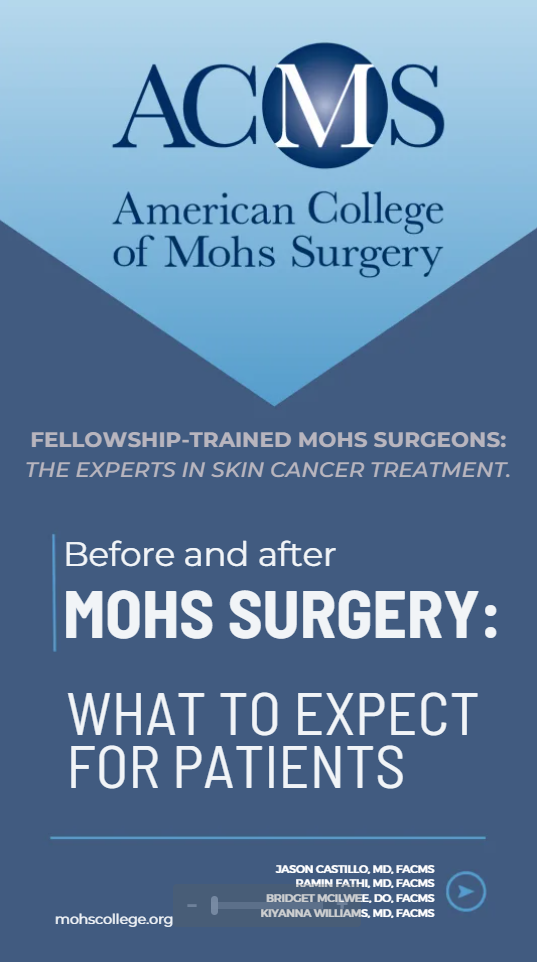Surgical Treatments
Skin Cancer Treatment
Each year, more than 3.3 million Americans are diagnosed with skin cancer. While skin cancer is not always life threatening, it can progress if left untreated. Memphis Dermatology Clinic offers the most advanced treatment for skin cancer: Mohs micrographic surgery. This procedure offers the greatest potential for cure, 98% or higher, while minimizing the cosmetic impact on the patient.
This highly innovative and successful procedure involves removing the tumor, along with a very thick layer of skin tissue, which is immediately frozen and microscopically examined for cancer cells. If cancer cells are found, an additional thin layer of tissue from that very specific area of concern is removed and microscopically examined for cancer cells. If evidence of disease exists, the process continues, as layer by layer the cancer is traced out until it is completely gone. With Mohs surgery, only affected skin is removed, preserving as much of the surrounding healthy tissue as possible, thus minimizing the cosmetic impact. Mohs surgery is performed with local anesthetic as an outpatient procedure.
Mohs surgery is very effective for skin cancers that:
- Are located in cosmetically sensitive areas or areas that are essential to functioning, e.g., skin around the ears, nose, lips, and the scalp;
- Have been previously treated (recurrent);
- Are large and difficult to treat.
Our goal at Memphis Dermatology Clinic is to ensure your total comfort and understanding of any surgery; for that purpose, the following is a detailed outline of this procedure.
Surgery Preparation
Because we want all of our patients to be as comfortable, relaxed and informed as possible, we recommend that you read all information we provide to you regarding the procedure and ask questions. Prior to surgery, it is important to be well rested, to eat a good breakfast and to plan to spend a few hours at our facility (we suggest you bring reading material or a device and ear phones as MDC does provide complimentary wifi). You may want to have someone accompany you to drive you home.
Your physician will be assisted by a team of nurses, medical assistants, and lab technicians who will be involved in your care. Local anesthesia is used to numb the area prior to the removal of tissue. Our office laboratory processes the tissue into multiple frozen sections. This usually takes about 45 minutes. If the microscopic examination of the frozen sections reveals additional skin cancer cells, we will continue the process, removing only residual tumor and sparing the healthy skin.
Immediately following surgery, you may experience some pain, which can usually be managed with an over-the-counter pain reliever. Significant blood loss following Mohs Micrographic Surgery is rare, but if you experience bleeding, please contact our office.
Healing
In order to facilitate the healing process, it is very important to take good care of yourself following your procedure. Your physician or nurse will provide you with detailed information on how to care for your wound. Healing options will be discussed with you once surgery is complete. Some surgical wounds health best when left open, while others heal best with closure by placement of sutures. In unusual cases, your physician may refer you to a plastic surgeon for repair of the wound.
Follow-up Visits
We may make periodic follow-up appointments for you until your wound has healed. It is important to know that once you have developed a skin cancer, you are more susceptible to developing additional skin cancers in the future.
Some of the above content adapted from DermSurgery.org.
Other Procedures
Common medical dermatology conditions we see and treat at Memphis Dermatology:
- Acne
- Psoriasis
- Eczema
- Seborrheic Dermatitis
- Rosacea
- Hair Loss/Alopecia
- Lupus
- Sarcoidosis
- Atopic Dermatitis
- Warts
- Drug Eruptions
- Insect Bites
- Scabies
- Fungal and Bacterial Infections of the Skin
- Contact Dermatitis
- Zoster

